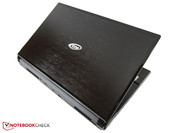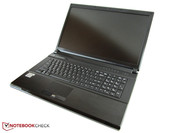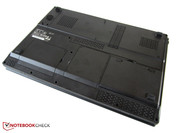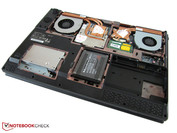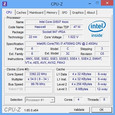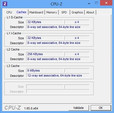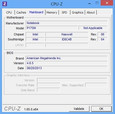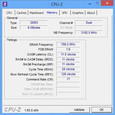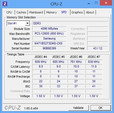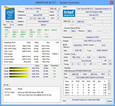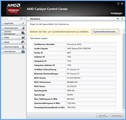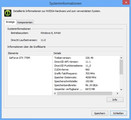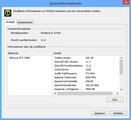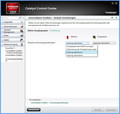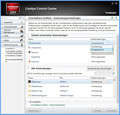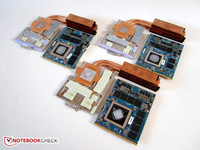Review AMD Radeon HD 8970M
For the original German article, see here.
While the Radeon HD 7970M competed against the contenders from Intel (checkpoint) just under one year ago, we now ordered the Radeon HD 8970M for a test. Can AMD win in performance per price or does it again struggle with a chaotic driver? Apart from performance, graphics switch and specs, we also scrutinize system noise, temperature, and power consumption.
Test system
One was one of the first manufacturers who made the promising Radeon HD 8970M available to us. Inside a 17-inch Clevo barebone (P170SM alias One K73-3N) the premium GPU hunts for high scores. The DirectX 11 model was combined with 8 GB DDR3 RAM (2x 4096 MB @ 1600 MHz) and a 2.4-3.4 GHz Core i7-4700MQ for performance reasons. We copied our huge test directory (more than 30 games) to the 500 GB Samsung SSD 840, on which Windows 8 64-bit was installed.
In order to make the competition as fair as possible, we replaced the Radeon HD 8970M with the GeForce GTX 770M and the GTX 780M for several measurements. So, the synthetic benchmarks and the emissions are absolutely comparable. We only used "old" values for the CAD and gaming benchmarks. ForceWare 320.49 was used as the Nvidia driver on our test system and the Clevo driver 12.103.0.0 for the Radeon HD 8970M.
Specifications
Strictly speaking, AMD's new high-end graphics card is only a faster version of the Radeon HD 7970M, which is also based on the GCN architecture. Apart from the core clock (900 vs. 850 MHz) and the memory clock (1250 vs. 1200 MHz) most of the specs are identical.
1280 shader units, 2.8 billion transistors, and a 256-bit interface hint at excellent performance. We feel doubling the RAM (4096 vs. 2048 MB GDDR5) was not necessary. Apparently, AMD wants to stand up to the GTX 780M in marketing. Nvidia's top model also features a memory bandwidth of 160 GB/s.
| Graphics Card | GeForce GTX 770M | GeForce GTX 680M | GeForce GTX 780M | Radeon HD 7970M | Radeon HD 8970M |
| Architecture | Kepler | Kepler | Kepler | GCN | GCN |
| Lithography | 28 nm | 28 nm | 28 nm | 28 nm | 28 nm |
| Shader units | 960 | 1344 | 1536 | 1280 | 1280 |
| Transistors | 3540 millions | 3540 millions | 3540 millions | 2800 millions | 2800 millions |
| Core clock | 811 MHz | 720 MHz | 823 MHz | 850 MHz | 900 MHz |
| Memory clock | 1000 MHz | 900 MHz | 1250 MHz | 1200 MHz | 1250 MHz |
| Memory type | GDDR5 | GDDR5 | GDDR5 | GDDR5 | GDDR5 |
| Memory capacity | 3072 MB | 4096 MB | 4096 MB | 2048 MB | 4096 MB |
| Memory interface | 192 Bit | 256 Bit | 256 Bit | 256 Bit | 256 Bit |
| Memory bandwidth | 96.2 GB/s | 115.2 GB/Sek | 160 GB/s | 153.6 GB/s | 160 GB/s |
Enduro
The automatic graphics switch (codename "Enduro") has been significantly improved since the launch of the HD 7970M. AMD not only improved the stability and the performance, but also added several functions.
Two special menus of the Catalyst Control Center (opens upon by right-clicking the desktop) allow an individual configuration. First of all, there are the global settings, which can be separately configured for battery and mains operation. If you do not want to take any risks, you set this option to "Maximize performance" and Enduro will reliably start 3D applications with the Radeon HD 8970M.
Apropos applications: In the driver menu with the same name, you can create and/or change profiles for .exe files. It lists all programs. As expected "Maximum performance" corresponds to the dedicated GPU, "Energy-saving" to the graphics chip integrated into the CPU (HD Graphics 4600 in the One K73-3N).
Nvidia's Optimus technology is still more mature than Enduro. Handy functions (direct selection by right-clicking in the info area of the task bar) are missing, and the recognition rate is worse. According to our experiences, the program database (decides which GPU is used in standard mode) of Nvidia is significantly better. Nevertheless, Enduro works properly and should not keep anybody from buying from AMD.
However, the graphics switch sometimes decreases performance (see Alienware M14x R4). In particular, the Nvidia graphics partly performs significantly better in undemanding games - at least in low to medium settings.
Driver
We (still) have to strongly advise against the official AMD drivers. Although the Catalyst versions 13.4 and 13.6 Beta (2) are designed for the 8000 series according to the manufacturer and the installation does not display an error message, we faced serious problems with our test sample.
Apart from the fact that some benchmarks and games (3DMark 11 & 2013, PCMark Vantage & 7, Windows Experience Index, SimCity) did not work at all, several hanged (Alan Wake, Mass Effect 3, Guild Wars 2, Risen 2) and annoying graphics errors could be observed. In nearly all DirectX 9 titles we saw double images and black bars (see pictures).
Currently, we cannot tell whether this is caused by the Clevo Barebone or AMD. With the original Clevo driver, whose version number is similar to the Catalyst 13.4 (12.104.0.0), the Radeon HD 8970M worked nearly flawlessly. During our tests, we did not face a single system crash or bluescreen. This is in contrast to the clumsy start of the Radeon HD 7970M (see our forum thread). We could only detect problems in three games:
- Assassin's Creed III: The AMD still performs significantly worse than the Nvidia.
- Borderlands 2: graphics errors (strange black lines) on the floor.
- Far Cry 3: incorrect shades (black blocks) in DirectX 11 mode; DirectX 11 mode stutters regardless of the frame rate.
Great: F1 2012, which caused problems for a long time, finally works flawlessly. The performance of the Clevo driver is impressive. Although Catalyst 13.6 Beta can increase the frame rate in newer games, DirectX 9 titles run slower. Let's wait to see what the coming months will bring. Anyway, the measurements in this article stem from the Clevo driver.
Synthetic Benchmarks
In the synthetic benchmarks, the graphics card performs excellently. Usually, the more expensive GeForce 770M from Nvidia does not stand a chance against the competitor from AMD. For example, in achieving 5110 points in the Fire Strike test of 3DMark 2013, the Radeon 8970M surpasses the Nvidia's GPU score of 3729 by just under 40%. The GeForce GTX 780M has the lead: 5744 points correspond to +12%.
We briefly want to analyze Unigine Heaven 3.0, a second DirectX 11 benchmark. The Radeon 7970M can smoothly master 1920x1080 pixels, high details, and standard tessellation. An average of 61.1 fps is excellent. While the GeForce GTX 780M is about 25% faster (76.8 fps), the GTX 770M is about 20% slower (51 fps). In 3DMark 11 and 3DMark Vantage, the HD 8970M also ranges in the middle between the competitors from Nvidia. Given the moderate price, the performance is excellent.
| Unigine Heaven 3.0 - 1920x1080 DX 11, Normal Tessellation, High Shaders AA:Off AF:Off (sort by value) | |
| Radeon HD 8970M (12.103.0.0) / Core i7-4700MQ | |
| GeForce GTX 770M (320.49) / Core i7-4700MQ | |
| GeForce GTX 780M (320.49) / Core i7-4700MQ | |
| Unigine Heaven 2.1 - 1280x1024 high, Tesselation (normal), DirectX11 AA:off AF:1x (sort by value) | |
| Radeon HD 8970M (12.103.0.0) / Core i7-4700MQ | |
| GeForce GTX 770M (320.49) / Core i7-4700MQ | |
| GeForce GTX 780M (320.49) / Core i7-4700MQ | |
| 3DMark | |
| 1920x1080 Fire Strike Graphics (sort by value) | |
| Radeon HD 8970M (12.103.0.0) / Core i7-4700MQ | |
| GeForce GTX 770M (320.49) / Core i7-4700MQ | |
| GeForce GTX 780M (320.49) / Core i7-4700MQ | |
| 1280x720 Cloud Gate Standard Graphics (sort by value) | |
| Radeon HD 8970M (12.103.0.0) / Core i7-4700MQ | |
| GeForce GTX 770M (320.49) / Core i7-4700MQ | |
| GeForce GTX 780M (320.49) / Core i7-4700MQ | |
| 1280x720 Ice Storm Standard Graphics (sort by value) | |
| Radeon HD 8970M (12.103.0.0) / Core i7-4700MQ | |
| GeForce GTX 770M (320.49) / Core i7-4700MQ | |
| GeForce GTX 780M (320.49) / Core i7-4700MQ | |
| 3DMark 11 - 1280x720 Performance GPU (sort by value) | |
| Radeon HD 8970M (12.103.0.0) / Core i7-4700MQ | |
| GeForce GTX 770M (320.49) / Core i7-4700MQ | |
| GeForce GTX 780M (320.49) / Core i7-4700MQ | |
| 3DMark Vantage - 1280x1024 P GPU no PhysX (sort by value) | |
| Radeon HD 8970M (12.103.0.0) / Core i7-4700MQ | |
| GeForce GTX 770M (320.49) / Core i7-4700MQ | |
| GeForce GTX 780M (320.49) / Core i7-4700MQ | |
| 3DMark 06 - 1280x1024 Standard Score AA:0x AF:0x (sort by value) | |
| Radeon HD 8970M (12.103.0.0) / Core i7-4700MQ | |
| GeForce GTX 770M (320.49) / Core i7-4700MQ | |
| GeForce GTX 780M (320.49) / Core i7-4700MQ | |
CAD Benchmarks
CAD is known to be dominated by AMD. This does not change with the current generation. According to the table below, the Radeon HD 8970M easily outperforms the other high-end models. Even the GeForce GTX 780M is mostly 40-90% slower in SPECviewperf 11. Nvidia only wins by a small margin in Catia.
Gaming Performance
Summarizing over all games, the Radeon HD 8970M is more than 20% faster than the GeForce GTX 770M. Despite a huge extra charge of 300 Euros (~$398), the lead of the GTX 780M is rather small. In our opinion, a performance gain of about 15% does not justify buying it. However, future driver versions might have an impact on the performance differences. The previous high-end models, the Radeon HD 7970M and the GeForce GTX 680M are about 10% slower.
In general, the performance of the Radeon HD 8970M is sufficient to run most of the games with (very) high graphics options and multiple anti-aliasing without stuttering. Only in very demanding games, e.g., Company of Heroes 2, Metro: Last Light, Crysis 3, and Far Cry 3 you cannot set all controls to maximum. Most of the popular games (Battlefield 3, Skyrim, Black Ops 2 etc.) will run with above 40 fps. The Radeon HD 8970M can nearly always cope with high details and a resolution of 1920x1080 pixels.
As usual, there are several outliers. Apart from Assassin's Creed III, F1 2012 and Diablo III also favor Nvidia, while Hitman: Absolution, SimCity, and Max Payne 3 have a bias towards AMD.
| Company of Heroes 2 - 1920x1080 Maximum / Higher / High AA:High (sort by value) | |
| Radeon HD 8970M (12.103.0.0) / Core i7-4700MQ | |
| Radeon HD 7970M (mixed) / Core i7-3610QM | |
| GeForce GTX 680M (mixed) / Core i7-3610QM | |
| GeForce GTX 770M (320.49) / Core i7-4700MQ | |
| GeForce GTX 780M (320.49) / Core i7-4700MQ | |
| GRID 2 - 1920x1080 Ultra Preset AA:4xMS (sort by value) | |
| Radeon HD 8970M (12.103.0.0) / Core i7-4700MQ | |
| Radeon HD 7970M (mixed) / Core i7-3610QM | |
| GeForce GTX 680M (mixed) / Core i7-3610QM | |
| GeForce GTX 770M (320.49) / Core i7-4700MQ | |
| GeForce GTX 780M (320.49) / Core i7-4700MQ | |
| Metro: Last Light - 1920x1080 Very High (DX11) AF:16x (sort by value) | |
| Radeon HD 8970M (12.103.0.0) / Core i7-4700MQ | |
| Radeon HD 7970M (mixed) / Core i7-3610QM | |
| GeForce GTX 680M (mixed) / Core i7-3610QM | |
| GeForce GTX 770M (320.49) / Core i7-4700MQ | |
| GeForce GTX 780M (320.49) / Core i7-4700MQ | |
| BioShock Infinite - 1920x1080 Ultra Preset, DX11 (DDOF) (sort by value) | |
| Radeon HD 8970M (12.103.0.0) / Core i7-4700MQ | |
| Radeon HD 7970M (mixed) / Core i7-3610QM | |
| GeForce GTX 680M (mixed) / Core i7-3610QM | |
| GeForce GTX 770M (311.27) / Core i7-4800MQ | |
| GeForce GTX 780M (311.27) / Core i7-4700MQ | |
| SimCity - 1920x1080 Ultra / High AA:on (sort by value) | |
| Radeon HD 8970M (12.103.0.0) / Core i7-4700MQ | |
| Radeon HD 7970M (mixed) / Core i7-3610QM | |
| GeForce GTX 680M (mixed) / Core i7-3610QM | |
| GeForce GTX 770M (311.27) / Core i7-4800MQ | |
| GeForce GTX 780M (311.27) / Core i7-4700MQ | |
| Tomb Raider - 1920x1080 Ultra Preset AA:FX AF:16x (sort by value) | |
| Radeon HD 8970M (12.103.0.0) / Core i7-4700MQ | |
| Radeon HD 7970M (mixed) / Core i7-3610QM | |
| GeForce GTX 680M (mixed) / Core i7-3610QM | |
| GeForce GTX 770M (311.27) / Core i7-4800MQ | |
| GeForce GTX 780M (311.27) / Core i7-4700MQ | |
| Crysis 3 - 1920x1080 Very High Preset AA:2xSM AF:16x (sort by value) | |
| Radeon HD 8970M (12.103.0.0) / Core i7-4700MQ | |
| Radeon HD 7970M (mixed) / Core i7-3610QM | |
| GeForce GTX 680M (mixed) / Core i7-3610QM | |
| GeForce GTX 770M (311.27) / Core i7-4800MQ | |
| GeForce GTX 780M (311.27) / Core i7-4700MQ | |
| Dead Space 3 - 1920x1080 Very High Preset (sort by value) | |
| Radeon HD 8970M (12.103.0.0) / Core i7-4700MQ | |
| Radeon HD 7970M (mixed) / Core i7-3610QM | |
| GeForce GTX 680M (mixed) / Core i7-3610QM | |
| GeForce GTX 770M (311.27) / Core i7-4800MQ | |
| GeForce GTX 780M (311.27) / Core i7-4700MQ | |
| Far Cry 3 - 1920x1080 DX11 Ultra Preset (HDAO, Enhanced Alpha To Coverage) AA:4x MS (sort by value) | |
| Radeon HD 8970M (12.103.0.0) / Core i7-4700MQ | |
| Radeon HD 7970M (Cat. 12.11) / Core i7-3610QM | |
| GeForce GTX 680M (mixed) / Core i7-3610QM | |
| GeForce GTX 770M (311.27) / Core i7-4800MQ | |
| GeForce GTX 780M (311.27) / Core i7-4700MQ | |
| Assassin´s Creed III - 1920x1080 Very High (sort by value) | |
| Radeon HD 8970M (12.103.0.0) / Core i7-4700MQ | |
| Radeon HD 7970M (Cat. 12.11) / Core i7-3610QM | |
| GeForce GTX 680M (mixed) / Core i7-3610QM | |
| GeForce GTX 770M (311.27) / Core i7-4800MQ | |
| GeForce GTX 780M (311.27) / Core i7-4700MQ | |
| Hitman: Absolution - 1920x1080 Ultra Preset AA:4xMS AF:16x (sort by value) | |
| Radeon HD 8970M (12.103.0.0) / Core i7-4700MQ | |
| Radeon HD 7970M (Cat. 12.11) / Core i7-3610QM | |
| GeForce GTX 680M (mixed) / Core i7-3610QM | |
| GeForce GTX 770M (311.27) / Core i7-4800MQ | |
| GeForce GTX 780M (311.27) / Core i7-4700MQ | |
| Call of Duty: Black Ops 2 - 1920x1080 (Extra) High / On, FXAA AA:4xMS (sort by value) | |
| Radeon HD 8970M (12.103.0.0) / Core i7-4700MQ | |
| Radeon HD 7970M (Cat. 12.11) / Core i7-3610QM | |
| GeForce GTX 680M (mixed) / Core i7-3610QM | |
| GeForce GTX 770M (311.27) / Core i7-4800MQ | |
| GeForce GTX 780M (311.27) / Core i7-4700MQ | |
| Need for Speed: Most Wanted - 1920x1080 High / On (sort by value) | |
| Radeon HD 8970M (12.103.0.0) / Core i7-4700MQ | |
| Radeon HD 7970M (Cat. 12.11) / Core i7-3610QM | |
| GeForce GTX 680M (mixed) / Core i7-3610QM | |
| GeForce GTX 770M (311.27) / Core i7-4800MQ | |
| GeForce GTX 780M (311.27) / Core i7-4700MQ | |
| Medal of Honor: Warfighter - 1920x1080 Ultra Preset AA:4xMS AF:16x (sort by value) | |
| Radeon HD 8970M (12.103.0.0) / Core i7-4700MQ | |
| Radeon HD 7970M (Cat. 12.11) / Core i7-3610QM | |
| GeForce GTX 680M (mixed) / Core i7-3610QM | |
| GeForce GTX 770M (311.27) / Core i7-4800MQ | |
| GeForce GTX 780M (311.27) / Core i7-4700MQ | |
| Dishonored - 1920x1080 High / On, FOV: 75 AA:FX (sort by value) | |
| Radeon HD 8970M (12.103.0.0) / Core i7-4700MQ | |
| Radeon HD 7970M (mixed) / Core i7-3610QM | |
| GeForce GTX 680M (mixed) / Core i7-3610QM | |
| GeForce GTX 770M (311.27) / Core i7-4800MQ | |
| GeForce GTX 780M (311.27) / Core i7-4700MQ | |
| Fifa 13 - 1920x1080 High AA:4xMS (sort by value) | |
| Radeon HD 8970M (12.103.0.0) / Core i7-4700MQ | |
| Radeon HD 7970M (mixed) / Core i7-3610QM | |
| GeForce GTX 680M (mixed) / Core i7-3610QM | |
| GeForce GTX 770M (311.27) / Core i7-4800MQ | |
| GeForce GTX 780M (311.27) / Core i7-4700MQ | |
| Borderlands 2 - 1920x1080 (Ultra) High / On (PhysX low) AA:FX AF:8x (sort by value) | |
| Radeon HD 8970M (12.103.0.0) / Core i7-4700MQ | |
| Radeon HD 7970M (mixed) / Core i7-3610QM | |
| GeForce GTX 680M (mixed) / Core i7-3610QM | |
| GeForce GTX 770M (311.27) / Core i7-4800MQ | |
| GeForce GTX 780M (311.27) / Core i7-4700MQ | |
| F1 2012 - 1920x1080 Ultra Preset AA:4xMS (sort by value) | |
| Radeon HD 8970M (12.103.0.0) / Core i7-4700MQ | |
| GeForce GTX 680M (mixed) / Core i7-3610QM | |
| GeForce GTX 770M (311.27) / Core i7-4800MQ | |
| GeForce GTX 780M (311.27) / Core i7-4700MQ | |
| Guild Wars 2 - 1920x1080 All Maximum / On AA:FX (sort by value) | |
| Radeon HD 8970M (12.103.0.0) / Core i7-4700MQ | |
| Radeon HD 7970M (mixed) / Core i7-3610QM | |
| GeForce GTX 680M (mixed) / Core i7-3610QM | |
| GeForce GTX 770M (311.27) / Core i7-4800MQ | |
| GeForce GTX 780M (311.27) / Core i7-4700MQ | |
| Counter-Strike: GO - 1920x1080 (Very) High, FXAA AA:4x MS AF:8x (sort by value) | |
| Radeon HD 8970M (12.103.0.0) / Core i7-4700MQ | |
| Radeon HD 7970M (mixed) / Core i7-3610QM | |
| GeForce GTX 680M (mixed) / Core i7-3610QM | |
| GeForce GTX 770M (311.27) / Core i7-4800MQ | |
| GeForce GTX 780M (311.27) / Core i7-4700MQ | |
| Sleeping Dogs - 1920x1080 Extreme Preset AA:Extreme (sort by value) | |
| Radeon HD 8970M (12.103.0.0) / Core i7-4700MQ | |
| Radeon HD 7970M (mixed) / Core i7-3610QM | |
| GeForce GTX 680M (mixed) / Core i7-3610QM | |
| GeForce GTX 770M (311.27) / Core i7-4800MQ | |
| GeForce GTX 780M (311.27) / Core i7-4700MQ | |
| Darksiders II - 1920x1080 2/4 Shadows, No Ambient Occlusion, AA:Low (sort by value) | |
| Radeon HD 8970M (12.103.0.0) / Core i7-4700MQ | |
| Radeon HD 7970M (mixed) / Core i7-3610QM | |
| GeForce GTX 680M (mixed) / Core i7-3610QM | |
| GeForce GTX 770M (311.27) / Core i7-4800MQ | |
| GeForce GTX 780M (311.27) / Core i7-4700MQ | |
| Max Payne 3 - 1920x1080 Very High, DX11 AA:Very High FX AF:8x (sort by value) | |
| Radeon HD 8970M (12.103.0.0) / Core i7-4700MQ | |
| GeForce GTX 680M (302.75) / Core i7-3610QM | |
| GeForce GTX 770M (311.27) / Core i7-4800MQ | |
| GeForce GTX 780M (311.27) / Core i7-4700MQ | |
| Risen 2: Dark Waters - 1920x1080 Ultra / on AA:on AF:8x (sort by value) | |
| Radeon HD 8970M (12.103.0.0) / Core i7-4700MQ | |
| Radeon HD 7970M (8.934.2.0) / Core i7-3610QM | |
| GeForce GTX 680M (302.75) / Core i7-3610QM | |
| GeForce GTX 770M (311.27) / Core i7-4800MQ | |
| GeForce GTX 780M (311.27) / Core i7-4700MQ | |
| The Elder Scrolls V: Skyrim - 1920x1080 Ultra Preset AA:8x AF:16x (sort by value) | |
| Radeon HD 8970M (12.103.0.0) / Core i7-4700MQ | |
| Radeon HD 7970M (8.934.2.0) / Core i7-3610QM | |
| GeForce GTX 680M (302.75) / Core i7-3610QM | |
| GeForce GTX 770M (311.27) / Core i7-4800MQ | |
| GeForce GTX 780M (311.27) / Core i7-4700MQ | |
| CoD: Modern Warfare 3 - 1920x1080 Extra, all on, Image Quality: Native AA:4x (sort by value) | |
| Radeon HD 8970M (12.103.0.0) / Core i7-4700MQ | |
| Radeon HD 7970M (8.934.2.0) / Core i7-3610QM | |
| GeForce GTX 680M (302.75) / Core i7-3610QM | |
| GeForce GTX 770M (311.27) / Core i7-4800MQ | |
| GeForce GTX 780M (311.27) / Core i7-4700MQ | |
System Noise
As the barebone manufacturer Clevo does not put much effort into fan control and focuses on temperatures, the One K73-3N is equally loud regardless of whether it is equipped with a GTX 770M, HD 8970M, or GTX 780M. 35 dB while idle and 54 dB after half an hour of 3D load (we used Battlefield 3) are above average. However, the system noise will depend on the graphics card in other notebooks.
Temperature
In temperature, the differences are big. With 72 °C, the Radeon HD 8970M is about on par with the GeForce GTX 770M's 3D result of 67 °C during Battlefield 3. We are somewhat concerned about the result of the GeForce GTX 780M: 86 °C is not ideal. While idle, the temperatures range between 38 and 41 °C. If GPU-Z is right, the clock rates of the Nvidia graphics cards fall slightly more than AMD's.
Power Consumption
In power consumption, neither the AMD nor the Nvidia wins. Thanks to the graphics switch, the One K73-3N needs about 24-25 Watt with each graphics card while idle (maximum display brightness, Windows profile "balanced"). The energy demand increases heavily under load: 138 Watt with Radeon HD 8970M equals the average from GeForce GTX 770M (122 Watt) and GTX 780M (153 Watt).
Verdict
The Radeon HD 8970M proves to be a thoroughly good high-end graphics cards. As long as you get hold of a flawless driver, the DirectX 11 model works reliably. Although the graphics switch still cannot keep up with Nvidia's, reasonably experienced gamers will be able to cope well with it.
The price performance ratio is particularly impressive. Alike the Radeon HD 7970M, the successor delivers a lot of performance for the price. Nvidia should seriously think about the price of its models. Considering the benchmark results the GeForce GTX 770M and the GeForce GTX 780M are too expensive.
Overall, we feel that the Radeon HD 8970M is the "most reasonable" premium GPU. Who produces the best graphics card is a matter of opinion. But this is for sure: This time AMD should avoid a chaotic release.





